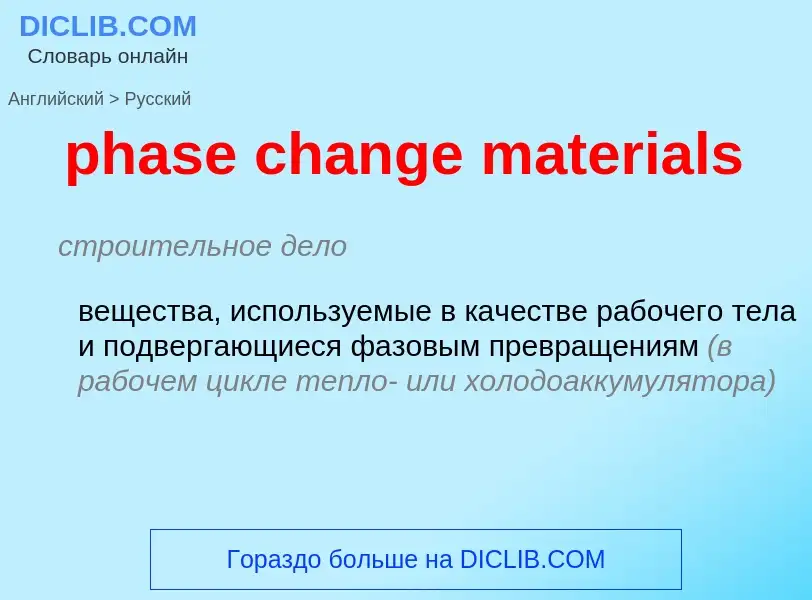Перевод и анализ слов искусственным интеллектом ChatGPT
На этой странице Вы можете получить подробный анализ слова или словосочетания, произведенный с помощью лучшей на сегодняшний день технологии искусственного интеллекта:
- как употребляется слово
- частота употребления
- используется оно чаще в устной или письменной речи
- варианты перевода слова
- примеры употребления (несколько фраз с переводом)
- этимология
phase change materials - перевод на русский
строительное дело
вещества, используемые в качестве рабочего тела и подвергающиеся фазовым превращениям (в рабочем цикле тепло- или холодоаккумулятора)
нефтегазовая промышленность
фазовое превращение
общая лексика
фазовый переход
общая лексика
изменение состояния
общая лексика
фазовый переход
фазовое превращение
переход агрегатный
математика
переход из одного состояния в другое
Определение
1) Период, стадия, этап в развитии чего-л.
2) Само положение, форма чего -л. в данный момент; фазис.
2. ж.
Величина, характеризующая состояние какого-л. процесса в каждый момент времени (в физике).
3. ж.
Однородная часть какой-л. неоднородной системы (в химии).
4. ж.
Отдельная группа обмоток генератора, а также присоединенный к ней провод, передающий электрический ток (в электротехнике).
Википедия

A phase change material (PCM) is a substance which releases/absorbs sufficient energy at phase transition to provide useful heat or cooling. Generally the transition will be from one of the first two fundamental states of matter - solid and liquid - to the other. The phase transition may also be between non-classical states of matter, such as the conformity of crystals, where the material goes from conforming to one crystalline structure to conforming to another, which may be a higher or lower energy state.
The energy released/absorbed by phase transition from solid to liquid, or vice versa, the heat of fusion is generally much higher than the sensible heat. Ice, for example, requires 333.55 J/g to melt, but then water will rise one degree further with the addition of just 4.18 J/g. Water/ice is therefore a very useful phase change material and has been used to store winter cold to cool buildings in summer since at least the time of the Achaemenid Empire.
By melting and solidifying at the phase change temperature (PCT), a PCM is capable of storing and releasing large amounts of energy compared to sensible heat storage. Heat is absorbed or released when the material changes from solid to liquid and vice versa or when the internal structure of the material changes; PCMs are accordingly referred to as latent heat storage (LHS) materials.
There are two principal classes of phase change material: organic (carbon-containing) materials derived either from petroleum, from plants or from animals; and salt hydrates, which generally either use natural salts from the sea or from mineral deposits or are by-products of other processes. A third class is solid to solid phase change.
PCMs are used in many different commercial applications where energy storage and/or stable temperatures are required, including, among others, heating pads, cooling for telephone switching boxes, and clothing.
By far the biggest potential market is for building heating and cooling. In this application area, PCMs hold potential in light of the progressive reduction in the cost of renewable electricity, coupled with the intermittent nature of such electricity. This can result in a misfit between peak demand and availability of supply. In North America, China, Japan, Australia, Southern Europe and other developed countries with hot summers, peak supply is at midday while peak demand is from around 17:00 to 20:00. This creates opportunities for thermal storage media.
Solid-liquid phase change materials are usually encapsulated for installation in the end application, to contain in the liquid state. In some applications, especially when incorporation to textiles is required, phase change materials are micro-encapsulated. Micro-encapsulation allows the material to remain solid, in the form of small bubbles, when the PCM core has melted.

![A [[sodium acetate]] [[heating pad]]. When the sodium acetate solution crystallises, it becomes warm. A [[sodium acetate]] [[heating pad]]. When the sodium acetate solution crystallises, it becomes warm.](https://commons.wikimedia.org/wiki/Special:FilePath/Handwaermer12.jpg?width=200)


![A small piece of rapidly melting solid [[argon]] shows two concurrent phase changes. The transition from solid to liquid, and gas to liquid (shown by the white condensed water vapour). A small piece of rapidly melting solid [[argon]] shows two concurrent phase changes. The transition from solid to liquid, and gas to liquid (shown by the white condensed water vapour).](https://commons.wikimedia.org/wiki/Special:FilePath/Argon ice 1.jpg?width=200)
